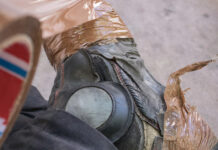You are on your feet, working most of the day, so naturally your feet require specialized care. A doctor specializing in foot care is a podiatrist. He can contribute to your total health, starting at the feet. Whether you need regular preventive care or surgery to correct a deformity, information is the strongest weapon against foot ailments. In order to keep your feet healthy, be familiar with the most common ills that affect them. Be aware that self-treatment can often turn a minor problem into a major one, and is generally not advisable.
See a podiatric physician when any of the following conditions occur or persist. Athlete’s foot is a skin disease, usually starting between the toes or on the ottom of the feet, which can spread to other parts of the body. A fungus that commonly attacks the feet, because the wearing of shoes and hosiery fosters fungus growth, causes it. The signs of athlete’s foot are dry scaly skin, itching, inflammation, and blisters. You can help prevent infection by washing your feet daily with soap and warm water; drying carefully, especially between the toes; and changing shoes and hosiery regularly to decrease moisture. Athlete’s foot is not the only infection, fungal and otherwise, which afflicts the foot, and other dry skin/dermatitis conditions can be good reasons to see a doctor of podiatric medicine if a suspicious condition persists. Blisters are caused by skin friction. Don’t pop them. Apply moleskin or an adhesive bandage over a blister, and leave it on until it falls off naturally in the bath or shower. Keep your feet dry and always wear socks as a cushion between your feet and shoes. If a blister breaks, wash the area, apply an antiseptic, and cover with a sterile bandage.
Bunions are misaligned big toe joints that can become swollen and tender. The deformity causes the first joint of the big toe to slant outward, and the big toe to angle toward the other toes. Bunions tend to run in families, but shoes that are too narrow in the forefoot and toe can aggravate the tendency. There are conservative and preventive steps that can minimize the discomfort of a bunion, but surgery is frequently recommended to correct the problem.
Corns and calluses are protective layers of compacted, dead skin cells. They are caused by repeated friction and pressure from skin rubbing against bony areas or against an irregularity in a shoe. Corns ordinarily form on the toes and calluses on the soles of the feet. The friction and pressure can burn or otherwise be painful and may be relieved by moleskin or padding on the affected areas. Never cut corns or calluses with any instrument, and never apply home remedies, except under a podiatrist’s instructions.
Foot odor results from excessive perspiration from the more than 250,000 sweat glands in the foot. Daily hygiene is essential. Change your shoes daily to let each pair air out, and change your socks, perhaps even more frequently than daily. Foot powders and antiperspirants, and soaking in vinegar and water, can help lessen odor.
Hammertoe is a condition in which any of the toes are bent in a claw-like position. It occurs most frequently with the second toe, often when a bunion slants the big toe toward and under it, but any of the other three smaller toes can be affected. Although the condition usually stems from muscle imbalance, ill-fitting shoes or socks that cramp the toes often aggravate it. Avoid pressure on the toes as much as possible. Surgery may be necessary to realign the toes to their proper position.
Heel pain can generally be traced to faulty biomechanics, which place too much stress on the heel bone, ligaments, or nerves in the area. Stress could result while walking or jumping on hard surfaces, or from poorly made footwear; being overweight is also a major contributing factor. Heel spurs are growths of bone on the underside of the heel bone. They can occur without pain; pain may result when inflammation develops at the point where the spur forms. Both heel pain and heel spurs are often associated with plantar fasciitis, an inflammation of the long band of connective tissue running from the heel to the ball of the foot. Treatments may range from exercise and custom-made orthotics to anti-inflammatory medications or cortisone injections.
Ingrown nails are nails whose corners or sides dig painfully into the skin, often causing infection. They are frequently caused by improper nail trimming, but also by shoe pressure, injury, fungus infection, heredity, and poor foot structure. Toenails should be trimmed straight across, slightly longer than the end of the toe, with toenail clippers. If painful or infected, your podiatric physician may remove the ingrown portion of the nail; if the condition reoccurs frequently, your podiatrist may permanently remove the nail.
Warts are caused by a virus, which enters the skin through small cuts and infects the skin. Children, especially teenagers, tend to be more susceptible to warts than adults. Most warts are harmless and benign, even though painful and unsightly. Warts often come from walking barefooted on dirty surfaces or littered ground. There are several simple procedures, which your podiatric physician might use to remove warts.




